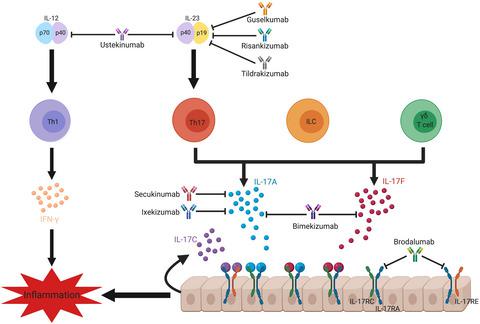当前位置:
X-MOL 学术
›
Clin. Exp. Immunol.
›
论文详情
Our official English website, www.x-mol.net, welcomes your
feedback! (Note: you will need to create a separate account there.)
IL-17 in inflammatory skin diseases psoriasis and hidradenitis suppurativa.
Clinical & Experimental Immunology ( IF 3.4 ) Pub Date : 2020-05-07 , DOI: 10.1111/cei.13449 J M Fletcher 1, 2 , B Moran 1 , A Petrasca 1 , C M Smith 1
Clinical & Experimental Immunology ( IF 3.4 ) Pub Date : 2020-05-07 , DOI: 10.1111/cei.13449 J M Fletcher 1, 2 , B Moran 1 , A Petrasca 1 , C M Smith 1
Affiliation

|
The skin is one of the most important organs in the body, providing integrity and acting as a barrier to exclude microbes, allergens and chemicals. However, chronic skin inflammation can result when barrier function is defective and immune responses are dysregulated or misdirected against harmless or self‐antigens. During the last 15 years interleukin (IL)‐17 cytokines have emerged as key players in multiple inflammatory disorders, and they appear to be especially prominent in skin inflammation. IL‐17 cytokines produced by T cells and other cell types potently activate keratinocytes to promote inflammation in a feed‐forward loop. Given this key pathogenic role of the IL‐17 pathway in autoimmune and inflammatory disease, it has been the focus of intense efforts to target therapeutically. The inflammatory effects of IL‐17 can be targeted directly by blocking the cytokine or its receptor, or indirectly by blocking cytokines upstream of IL‐17‐producing cells. Psoriasis has been the major success story for anti‐IL‐17 drugs, where they have proven more effective than in other indications. Hidradenitis suppurativa (HS) is another inflammatory skin disease which, despite carrying a higher burden than psoriasis, is poorly recognized and under‐diagnosed, and current treatment options are inadequate. Recently, a key role for the IL‐17 pathway in the pathogenesis of HS has emerged, prompting clinical trials with a variety of IL‐17 inhibitors. In this review, we discuss the roles of IL‐17A, IL‐17F and IL‐17C in psoriasis and HS and the strategies taken to target the IL‐17 pathway therapeutically.
中文翻译:

IL-17 在炎症性皮肤病银屑病和化脓性汗腺炎中的作用。
皮肤是人体最重要的器官之一,提供完整性并作为排除微生物、过敏原和化学物质的屏障。然而,当屏障功能有缺陷、免疫反应失调或误导无害或自身抗原时,可能会导致慢性皮肤炎症。在过去的 15 年中,白细胞介素 (IL)-17 细胞因子已成为多种炎症性疾病的关键因素,它们在皮肤炎症中显得尤为突出。T 细胞和其他细胞类型产生的 IL-17 细胞因子有效激活角质形成细胞,以促进前馈循环中的炎症。鉴于 IL-17 通路在自身免疫和炎症性疾病中的这一关键致病作用,它一直是靶向治疗的重点。IL-17 的炎症作用可以通过阻断细胞因子或其受体直接靶向,或通过阻断 IL-17 产生细胞上游的细胞因子间接靶向。银屑病一直是抗 IL-17 药物的主要成功案例,已证明它们比其他适应症更有效。化脓性汗腺炎 (HS) 是另一种炎症性皮肤病,尽管其负担比银屑病高,但其认识和诊断不足,目前的治疗方案也不充分。最近,IL-17 通路在 HS 发病机制中的关键作用已经出现,促进了各种 IL-17 抑制剂的临床试验。在这篇综述中,我们讨论了 IL-17A、IL-17F 和 IL-17C 在银屑病和 HS 中的作用以及治疗靶向 IL-17 通路的策略。或间接通过阻断 IL-17 产生细胞上游的细胞因子。银屑病一直是抗 IL-17 药物的主要成功案例,已证明它们比其他适应症更有效。化脓性汗腺炎 (HS) 是另一种炎症性皮肤病,尽管其负担比银屑病高,但其认识和诊断不足,目前的治疗方案也不充分。最近,IL-17 通路在 HS 发病机制中的关键作用已经出现,促进了各种 IL-17 抑制剂的临床试验。在这篇综述中,我们讨论了 IL-17A、IL-17F 和 IL-17C 在银屑病和 HS 中的作用以及治疗靶向 IL-17 通路的策略。或间接通过阻断 IL-17 产生细胞上游的细胞因子。银屑病一直是抗 IL-17 药物的主要成功案例,已证明它们比其他适应症更有效。化脓性汗腺炎 (HS) 是另一种炎症性皮肤病,尽管其负担比银屑病高,但其认识和诊断不足,目前的治疗方案也不充分。最近,IL-17 通路在 HS 发病机制中的关键作用已经出现,促进了各种 IL-17 抑制剂的临床试验。在这篇综述中,我们讨论了 IL-17A、IL-17F 和 IL-17C 在银屑病和 HS 中的作用以及治疗靶向 IL-17 通路的策略。事实证明,它们比其他适应症更有效。化脓性汗腺炎 (HS) 是另一种炎症性皮肤病,尽管其负担比银屑病高,但其认识和诊断不足,目前的治疗方案也不充分。最近,IL-17 通路在 HS 发病机制中的关键作用已经出现,促进了各种 IL-17 抑制剂的临床试验。在这篇综述中,我们讨论了 IL-17A、IL-17F 和 IL-17C 在银屑病和 HS 中的作用以及治疗靶向 IL-17 通路的策略。事实证明,它们比其他适应症更有效。化脓性汗腺炎 (HS) 是另一种炎症性皮肤病,尽管其负担比银屑病高,但其认识和诊断不足,目前的治疗方案也不充分。最近,IL-17 通路在 HS 发病机制中的关键作用已经出现,促进了各种 IL-17 抑制剂的临床试验。在这篇综述中,我们讨论了 IL-17A、IL-17F 和 IL-17C 在银屑病和 HS 中的作用以及治疗靶向 IL-17 通路的策略。IL-17 通路在 HS 发病机制中的关键作用已经出现,促使各种 IL-17 抑制剂的临床试验。在这篇综述中,我们讨论了 IL-17A、IL-17F 和 IL-17C 在银屑病和 HS 中的作用以及治疗靶向 IL-17 通路的策略。IL-17 通路在 HS 发病机制中的关键作用已经出现,促使各种 IL-17 抑制剂的临床试验。在这篇综述中,我们讨论了 IL-17A、IL-17F 和 IL-17C 在银屑病和 HS 中的作用以及治疗靶向 IL-17 通路的策略。
更新日期:2020-05-07
中文翻译:

IL-17 在炎症性皮肤病银屑病和化脓性汗腺炎中的作用。
皮肤是人体最重要的器官之一,提供完整性并作为排除微生物、过敏原和化学物质的屏障。然而,当屏障功能有缺陷、免疫反应失调或误导无害或自身抗原时,可能会导致慢性皮肤炎症。在过去的 15 年中,白细胞介素 (IL)-17 细胞因子已成为多种炎症性疾病的关键因素,它们在皮肤炎症中显得尤为突出。T 细胞和其他细胞类型产生的 IL-17 细胞因子有效激活角质形成细胞,以促进前馈循环中的炎症。鉴于 IL-17 通路在自身免疫和炎症性疾病中的这一关键致病作用,它一直是靶向治疗的重点。IL-17 的炎症作用可以通过阻断细胞因子或其受体直接靶向,或通过阻断 IL-17 产生细胞上游的细胞因子间接靶向。银屑病一直是抗 IL-17 药物的主要成功案例,已证明它们比其他适应症更有效。化脓性汗腺炎 (HS) 是另一种炎症性皮肤病,尽管其负担比银屑病高,但其认识和诊断不足,目前的治疗方案也不充分。最近,IL-17 通路在 HS 发病机制中的关键作用已经出现,促进了各种 IL-17 抑制剂的临床试验。在这篇综述中,我们讨论了 IL-17A、IL-17F 和 IL-17C 在银屑病和 HS 中的作用以及治疗靶向 IL-17 通路的策略。或间接通过阻断 IL-17 产生细胞上游的细胞因子。银屑病一直是抗 IL-17 药物的主要成功案例,已证明它们比其他适应症更有效。化脓性汗腺炎 (HS) 是另一种炎症性皮肤病,尽管其负担比银屑病高,但其认识和诊断不足,目前的治疗方案也不充分。最近,IL-17 通路在 HS 发病机制中的关键作用已经出现,促进了各种 IL-17 抑制剂的临床试验。在这篇综述中,我们讨论了 IL-17A、IL-17F 和 IL-17C 在银屑病和 HS 中的作用以及治疗靶向 IL-17 通路的策略。或间接通过阻断 IL-17 产生细胞上游的细胞因子。银屑病一直是抗 IL-17 药物的主要成功案例,已证明它们比其他适应症更有效。化脓性汗腺炎 (HS) 是另一种炎症性皮肤病,尽管其负担比银屑病高,但其认识和诊断不足,目前的治疗方案也不充分。最近,IL-17 通路在 HS 发病机制中的关键作用已经出现,促进了各种 IL-17 抑制剂的临床试验。在这篇综述中,我们讨论了 IL-17A、IL-17F 和 IL-17C 在银屑病和 HS 中的作用以及治疗靶向 IL-17 通路的策略。事实证明,它们比其他适应症更有效。化脓性汗腺炎 (HS) 是另一种炎症性皮肤病,尽管其负担比银屑病高,但其认识和诊断不足,目前的治疗方案也不充分。最近,IL-17 通路在 HS 发病机制中的关键作用已经出现,促进了各种 IL-17 抑制剂的临床试验。在这篇综述中,我们讨论了 IL-17A、IL-17F 和 IL-17C 在银屑病和 HS 中的作用以及治疗靶向 IL-17 通路的策略。事实证明,它们比其他适应症更有效。化脓性汗腺炎 (HS) 是另一种炎症性皮肤病,尽管其负担比银屑病高,但其认识和诊断不足,目前的治疗方案也不充分。最近,IL-17 通路在 HS 发病机制中的关键作用已经出现,促进了各种 IL-17 抑制剂的临床试验。在这篇综述中,我们讨论了 IL-17A、IL-17F 和 IL-17C 在银屑病和 HS 中的作用以及治疗靶向 IL-17 通路的策略。IL-17 通路在 HS 发病机制中的关键作用已经出现,促使各种 IL-17 抑制剂的临床试验。在这篇综述中,我们讨论了 IL-17A、IL-17F 和 IL-17C 在银屑病和 HS 中的作用以及治疗靶向 IL-17 通路的策略。IL-17 通路在 HS 发病机制中的关键作用已经出现,促使各种 IL-17 抑制剂的临床试验。在这篇综述中,我们讨论了 IL-17A、IL-17F 和 IL-17C 在银屑病和 HS 中的作用以及治疗靶向 IL-17 通路的策略。











































 京公网安备 11010802027423号
京公网安备 11010802027423号